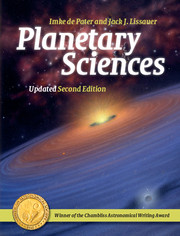Refine listing
Actions for selected content:
17000 results
Appendix E - Observing Techniques
-
- Book:
- Planetary Sciences
- Published online:
- 05 January 2015
- Print publication:
- 29 January 2015, pp 565-574
-
- Chapter
- Export citation
Appendix B - Acronyms Used
-
- Book:
- Planetary Sciences
- Published online:
- 05 January 2015
- Print publication:
- 29 January 2015, pp 559-561
-
- Chapter
- Export citation
Appendix A - List of Symbols Used
-
- Book:
- Planetary Sciences
- Published online:
- 05 January 2015
- Print publication:
- 29 January 2015, pp 554-558
-
- Chapter
- Export citation
References
-
- Book:
- Planetary Sciences
- Published online:
- 05 January 2015
- Print publication:
- 29 January 2015, pp 605-624
-
- Chapter
- Export citation
4 - Planetary Atmospheres
-
- Book:
- Planetary Sciences
- Published online:
- 05 January 2015
- Print publication:
- 29 January 2015, pp 76-151
-
- Chapter
- Export citation
7 - Magnetic Fields and Plasmas
-
- Book:
- Planetary Sciences
- Published online:
- 05 January 2015
- Print publication:
- 29 January 2015, pp 283-336
-
- Chapter
- Export citation
6 - Planetary Interiors
-
- Book:
- Planetary Sciences
- Published online:
- 05 January 2015
- Print publication:
- 29 January 2015, pp 241-282
-
- Chapter
- Export citation
8 - Meteorites
-
- Book:
- Planetary Sciences
- Published online:
- 05 January 2015
- Print publication:
- 29 January 2015, pp 337-365
-
- Chapter
- Export citation
Appendix C - Units and Constants
-
- Book:
- Planetary Sciences
- Published online:
- 05 January 2015
- Print publication:
- 29 January 2015, pp 562-563
-
- Chapter
- Export citation
11 - Planetary Rings
-
- Book:
- Planetary Sciences
- Published online:
- 05 January 2015
- Print publication:
- 29 January 2015, pp 448-488
-
- Chapter
- Export citation
9 - Minor Planets
-
- Book:
- Planetary Sciences
- Published online:
- 05 January 2015
- Print publication:
- 29 January 2015, pp 366-404
-
- Chapter
- Export citation
Index
-
- Book:
- Planetary Sciences
- Published online:
- 05 January 2015
- Print publication:
- 29 January 2015, pp 625-647
-
- Chapter
- Export citation
2 - Dynamics
-
- Book:
- Planetary Sciences
- Published online:
- 05 January 2015
- Print publication:
- 29 January 2015, pp 22-55
-
- Chapter
- Export citation
Contents
-
- Book:
- Planetary Sciences
- Published online:
- 05 January 2015
- Print publication:
- 29 January 2015, pp v-xii
-
- Chapter
- Export citation
Appendix D - Periodic Table of Elements
-
- Book:
- Planetary Sciences
- Published online:
- 05 January 2015
- Print publication:
- 29 January 2015, pp 564-564
-
- Chapter
- Export citation
Appendix F - Interplanetary Spacecraft
-
- Book:
- Planetary Sciences
- Published online:
- 05 January 2015
- Print publication:
- 29 January 2015, pp 575-580
-
- Chapter
- Export citation
List of Tables
-
- Book:
- Planetary Sciences
- Published online:
- 05 January 2015
- Print publication:
- 29 January 2015, pp xiii-xiii
-
- Chapter
- Export citation

Planetary Sciences
-
- Published online:
- 05 January 2015
- Print publication:
- 29 January 2015

In Pursuit of a Shadow
- By a Lady Astronomer
-
- Published online:
- 18 December 2014
- Print publication:
- 17 July 2014
- First published in:
- 1888

Essays from the Edinburgh and Quarterly Reviews
- With Addresses and Other Pieces
-
- Published online:
- 18 December 2014
- Print publication:
- 17 July 2014
- First published in:
- 1857
